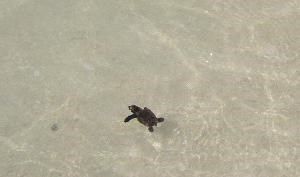
The VIIS Turtle monitoring program relies on volunteer labor. Consider joining us this year to help determine how many turtles are nesting and hatching on St. John. To sign up to be a volunteer, email vinpturtles@friendsvinp.org. Volunteer ExpectationsBeach monitoring season: July-November Beach monitoring: Dedicated and trained volunteers monitor assigned beaches at least 1-2 times a week from July-November looking for sea turtle nesting activity. Nests are protected and monitored throughout the duration of incubation. Volunteers Must:
Visit Sea Turtle | Friends of Virgin Islands National Park (friendsvinp.org) for news on turtle monitoring. The endangered hawksbill, green, and leatherback sea turtles nest on St. John. The survival of each individual of an endangered species is important. With your help we hope to:
General Nesting Information:The hawksbill turtle is one of the only remaining turtles to regularly nest on St. John. Females nest every other year or every two years, and they make their nests in the vegetation. She will commonly lay three, four or five clutches at 14-day intervals, generally on the same beach. Clutch sizes are usually between 100-200 eggs laid at one time but can decreases with each nest. The soft leathery white eggs are about the size of ping-pong balls; hatchlings are uniformly reddish-brown, just a bit smaller than a silver dollar. Leatherbacks are uncommon on St. John. Their nests are obvious because of the size of the disturbed area, usually mid-beach. They generally lay about 80 yolked eggs and 30 yolkless eggs per nest. Eggs are cue-ball sized. Incubation takes about 60 days and hatchlings are 2-3 times the size of a hawksbill hatchling. The first documented green sea turtle nest on St. John was found in 2017. Greens nest on the sandy beach and have one or more characteristically deep body pits. Greens lay between 75-200 eggs per nest and typically lay 3-6 nests per season. Please notify the VINP Sea Turtle Program at (340) 643-8560 or vinpturtles@friendsvinp.org if you suspect a hatch, predation, turtle stranding, or see baby turtles or shells on the beach. Learn more about turtles of the Virgin Islands here. |
Last updated: September 21, 2021
